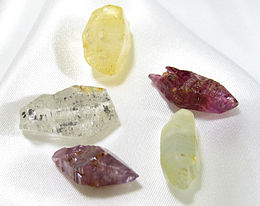
Back Korund Afrikaans Corindón AN كورندم Arabic Korund Azerbaijani Карунд Byelorussian Карунд BE-X-OLD Корунд Bulgarian Korund BS Corindó Catalan Korund Czech
| Corundum | |
|---|---|
 | |
| General | |
| Category | Oxide mineral – Hematite group |
| Formula (repeating unit) | Al2O3 |
| IMA symbol | Crn[1] |
| Strunz classification | 4.CB.05 |
| Dana classification | 4.3.1.1 |
| Crystal system | Trigonal |
| Crystal class | Hexagonal scalenohedral (3m) H-M symbol: (3 2/m) |
| Space group | R3c (No. 167) |
| Unit cell | a = 4.75 Å, c = 12.982 Å; Z = 6 |
| Identification | |
| Color | Colorless, gray, golden-brown, brown; purple, pink to red, orange, yellow, green, blue, violet; may be color zoned, asteriated mainly grey and brown |
| Crystal habit | Steep bipyramidal, tabular, prismatic, rhombohedral crystals, massive or granular |
| Twinning | Polysynthetic twinning common |
| Cleavage | None – parting in 3 directions |
| Fracture | Conchoidal to uneven |
| Tenacity | Brittle |
| Mohs scale hardness | 9 (defining mineral)[2] |
| Luster | Adamantine to vitreous |
| Streak | Colorless |
| Diaphaneity | Transparent, translucent to opaque |
| Specific gravity | 3.95–4.10 |
| Optical properties | Uniaxial (−) |
| Refractive index | nω = 1.767–1.772 nε = 1.759–1.763 |
| Pleochroism | None |
| Melting point | 2,044 °C (3,711 °F) |
| Fusibility | Infusible |
| Solubility | Insoluble |
| Alters to | May alter to mica on surfaces causing a decrease in hardness |
| Other characteristics | May fluoresce or phosphoresce under UV light |
| References | [3][4][5][6] |
| Major varieties | |
| Sapphire | Any color except red |
| Ruby | Red |
| Emery | Black granular corundum intimately mixed with magnetite, hematite, or hercynite |
Corundum is a crystalline form of aluminium oxide (Al2O3) typically containing traces of iron, titanium, vanadium, and chromium.[3][4] It is a rock-forming mineral. It is a naturally transparent material, but can have different colors depending on the presence of transition metal impurities in its crystalline structure.[7] Corundum has two primary gem varieties: ruby and sapphire. Rubies are red due to the presence of chromium, and sapphires exhibit a range of colors depending on what transition metal is present.[7] A rare type of sapphire, padparadscha sapphire, is pink-orange.
The name "corundum" is derived from the Tamil-Dravidian word kurundam (ruby-sapphire) (appearing in Sanskrit as kuruvinda).[8][9]
Because of corundum's hardness (pure corundum is defined to have 9.0 on the Mohs scale), it can scratch almost all other minerals. It is commonly used as an abrasive on sandpaper and on large tools used in machining metals, plastics, and wood. Emery, a variety of corundum with no value as a gemstone, is commonly used as an abrasive. It is a black granular form of corundum, in which the mineral is intimately mixed with magnetite, hematite, or hercynite.[6]
In addition to its hardness, corundum has a density of 4.02 g/cm3 (251 lb/cu ft), which is unusually high for a transparent mineral composed of the low-atomic mass elements aluminium and oxygen.[10]
- ^ Warr, L.N. (2021). "IMA–CNMNC approved mineral symbols". Mineralogical Magazine. 85 (3): 291–320. Bibcode:2021MinM...85..291W. doi:10.1180/mgm.2021.43. S2CID 235729616.
- ^ "Mohs' scale of hardness". Collector's corner. Mineralogical Society of America. Retrieved 10 January 2014.
- ^ a b Anthony, John W.; Bideaux, Richard A.; Bladh, Kenneth W.; Nichols, Monte C., eds. (1997). "Corundum". Handbook of Mineralogy (PDF). Vol. III Halides, Hydroxides, Oxides. Chantilly, VA, US: Mineralogical Society of America. ISBN 0962209724. Archived (PDF) from the original on 5 September 2006.
- ^ a b "Corundum". Mindat.org.
- ^ "Corundum". Webmineral.com. Archived from the original on 25 November 2006.
- ^ a b Hurlbut, Cornelius S.; Klein, Cornelis (1985). Manual of Mineralogy (20th ed.). Wiley. pp. 300–302. ISBN 0-471-80580-7.
- ^ a b Giuliani, Gaston; Ohnenstetter, Daniel; Fallick, Anthony E.; Groat, Lee; Fagan; Andrew J. (2014). "The Geology and Genesis of Gem Corundum Deposits". Gem Corundum. Research Gate: Mineralogical Association of Canada. pp. 37–38. ISBN 978-0-921294-54-2.
- ^ Harper, Douglas. "corundum". Online Etymology Dictionary.
- ^ Jeršek, Miha; Jovanovski, Gligor; Boev, Blažo; Makreski, Petre (2021). "Intriguing minerals: corundum in the world of rubies and sapphires with special attention to Macedonian rubies". ChemTexts. 7 (3): 19. doi:10.1007/s40828-021-00143-0. ISSN 2199-3793. S2CID 233435945.
- ^ "The Mineral Corundum". galleries.com.